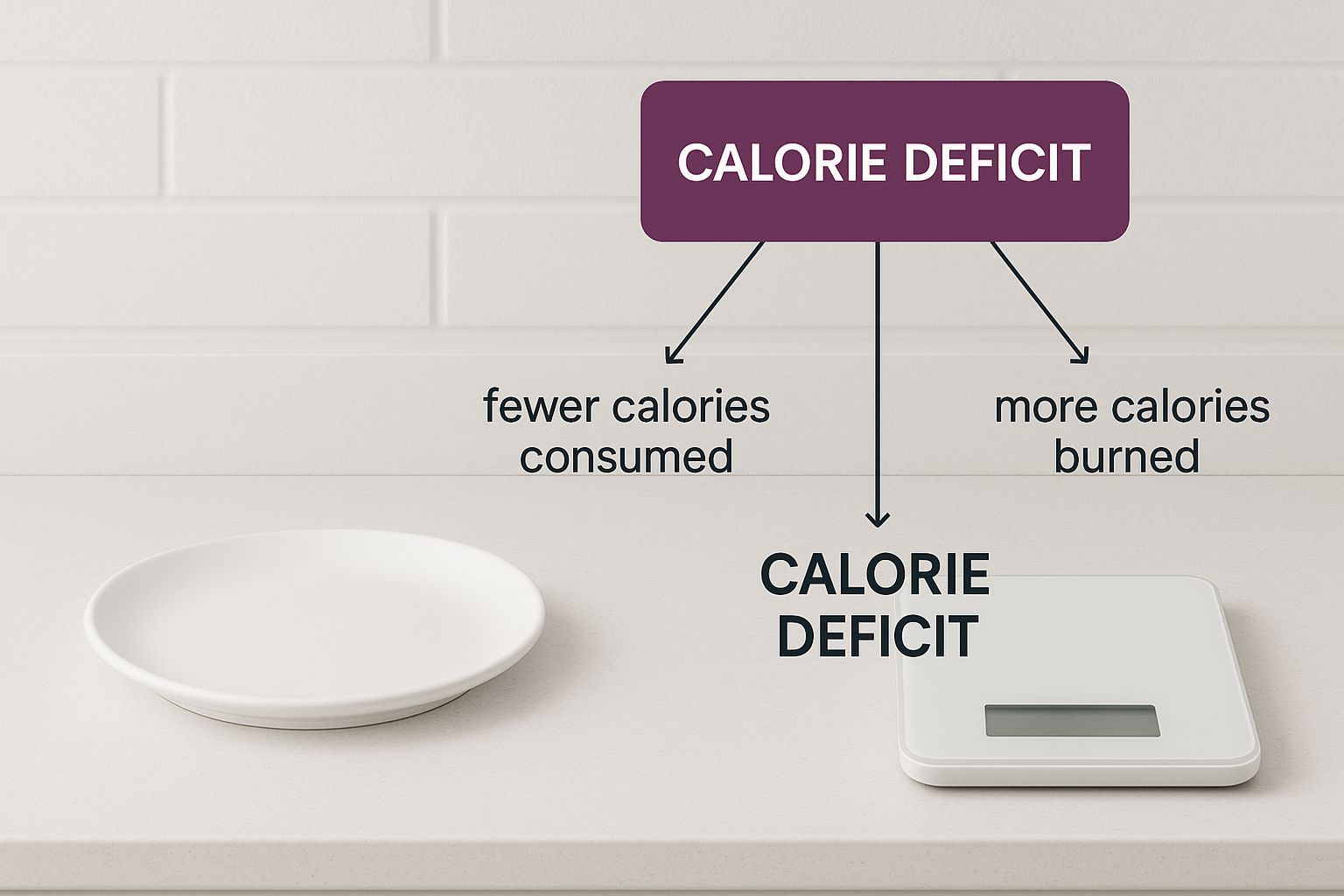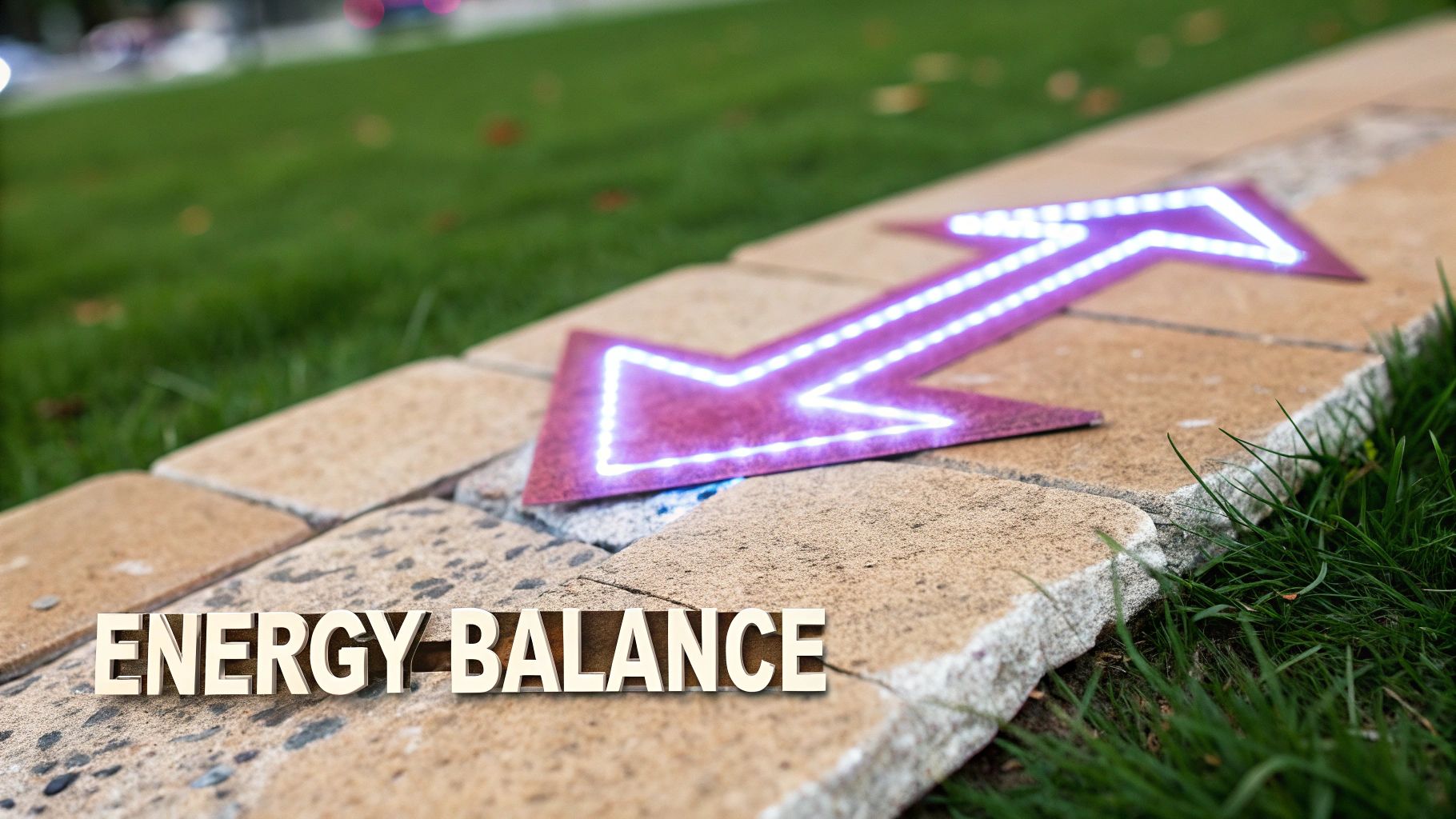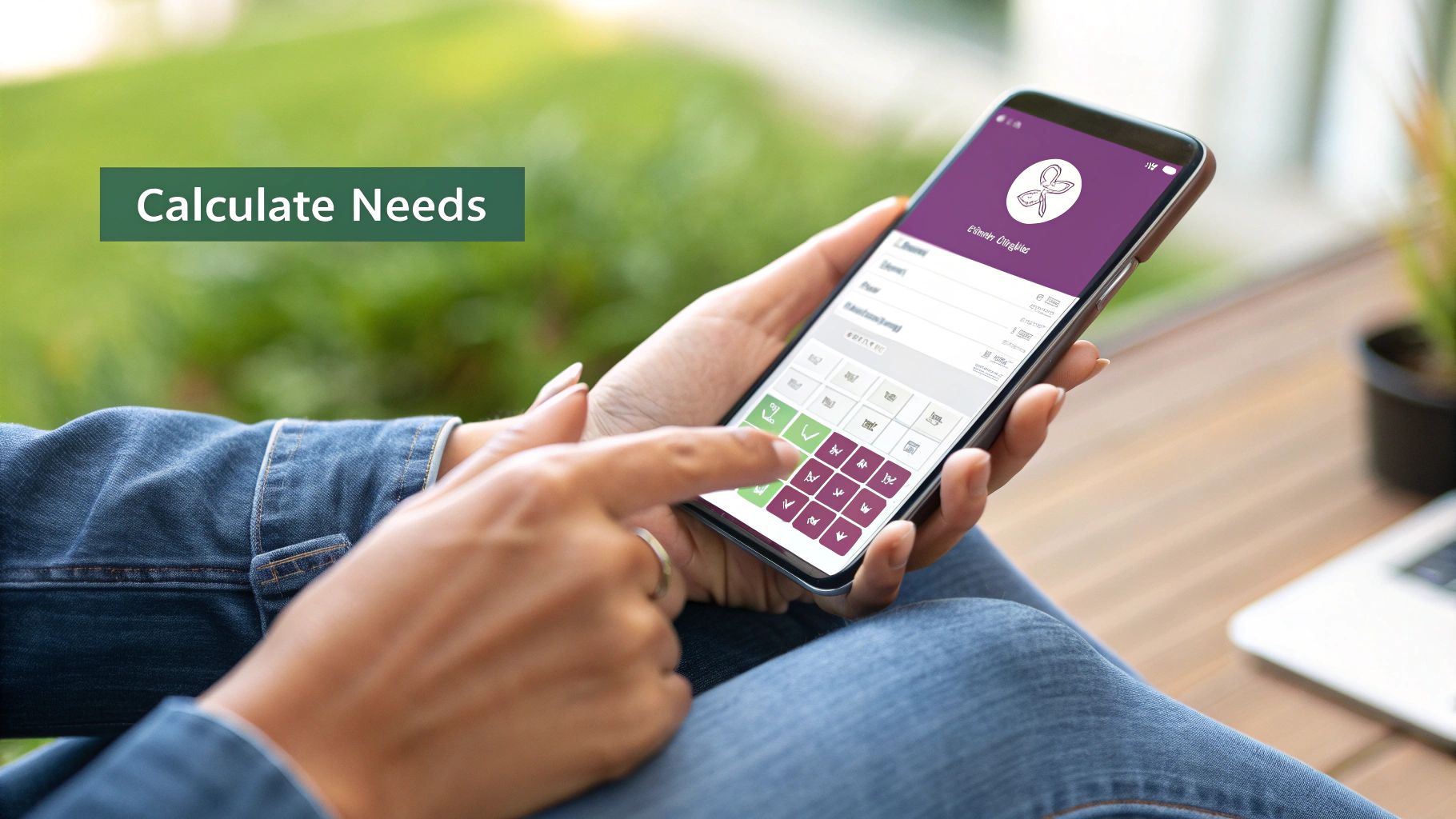
What Is Calorie Deficit? How It Works for Weight Loss
If you've ever wondered how people actually lose weight, it all boils down to one core principle: the calorie deficit.
A calorie deficit is when you burn more calories than you consume. Think of it as an energy budget. When you spend more energy than you take in, your body pulls from its energy savings account—your stored body fat.
This isn't a fad or a trick. It's the fundamental science behind every effective weight loss strategy.
The Foundation of Weight Loss
The easiest way to understand this is by thinking of your body's energy like a bank account.
The food and drinks you consume are your daily deposits (calories in). Everything you do—from breathing and digesting food to walking up the stairs and hitting the gym—is a withdrawal (calories out).
When your deposits match your withdrawals, you're in energy balance, and your weight stays the same. To lose weight, you must create a deficit. You need to withdraw more energy than you deposit, prompting your body to tap into its reserves.
This is the core idea visualized below—it's all about the balance between energy in and energy out.

The image drives home a simple point: a calorie deficit is about managing the relationship between what you eat and the energy you use every single day.
How Your Body Spends Energy
When people think about burning calories, exercise is usually the first thing that comes to mind. But that's only part of the story.
Your total daily energy expenditure (TDEE) is a combination of several different processes. Getting to know them helps you see all the different levers you can pull to create that deficit.
Your Daily Energy Expenditure Breakdown
This table breaks down the different ways your body uses the energy you give it.
| Component | Description | Approximate % of Total Expenditure |
|---|---|---|
| Resting Energy Expenditure (REE) | The energy your body needs just to stay alive—for things like breathing, circulating blood, and repairing cells. This is your biggest calorie burn. | 60-75% |
| Thermic Effect of Food (TEF) | Your body actually burns calories to digest and absorb the food you eat. Protein has the highest thermic effect, meaning it takes more energy to process. | ~10% |
| Physical Activity | This covers everything from planned workouts (like a run) to everyday movements like fidgeting or walking to the car, known as NEAT. | 15-30% |
Understanding this breakdown shows that you have multiple ways to influence your "calories out," not just by spending hours at the gym.
A deficit of about 500 calories per day typically leads to a safe and sustainable weight loss of about one pound per week. This is based on the idea that one pound of fat is roughly equivalent to 3,500 calories.
You can dive deeper into the science behind this by reading about how to create a sustainable calorie deficit on Healthline.com. A smart approach combines small dietary changes with a bit more movement to create a deficit that feels manageable, not miserable.
Figuring Out Your Own Calorie Needs
So, how does a calorie deficit apply to you? Your body isn't the same as anyone else's, so your daily calorie target won't be either. Let's turn this general idea into a specific, actionable number that works for you.

First, we need to find your "maintenance" number—the calories you need daily to stay at your current weight. Once we know that, creating a deficit is simple.
Start with Your BMR
Everything starts with your Basal Metabolic Rate (BMR). This is the minimum energy your body needs to function at rest. It's the calories you'd burn just keeping your heart beating, your lungs breathing, and your brain running.
A reliable method for estimating this is the Mifflin-St Jeor equation. It uses your weight, height, and age to give a solid estimate of your resting metabolism. You can dive deeper into the science of calculating your daily needs on medicalnewstoday.com if you're curious.
"Your BMR is the foundation of your energy expenditure. Understanding it is the first step toward personalizing your nutrition and achieving your fitness goals effectively."
Layer on Your Activity Level (TDEE)
Most of us don't lie in bed all day. We walk, work, and exercise. This is where your Total Daily Energy Expenditure (TDEE) comes in. It takes your BMR and adds in all the calories you burn from physical activity.
To find your TDEE, you just multiply your BMR by an activity factor.
Here’s how those multipliers typically break down:
- Sedentary: Desk job with little to no exercise (BMR x 1.2)
- Lightly Active: Light exercise or sports 1-3 days a week (BMR x 1.375)
- Moderately Active: Moderate exercise or sports 3-5 days a week (BMR x 1.55)
- Very Active: Hard exercise or sports 6-7 days a week (BMR x 1.725)
- Extra Active: Very hard exercise, a physical job, or training twice a day (BMR x 1.9)
For example, say a woman has a BMR of 1,400 calories. She works out 4 times a week, putting her in the "moderately active" category. Her TDEE would be 1,400 x 1.55, which equals 2,170 calories.
That 2,170 is her maintenance level. To lose weight, she needs to eat less than that. A 500-calorie deficit would mean aiming for around 1,670 calories per day. For anyone who is currently refining their diet, this graphical tee called Eat Clean Train Mean Live Lean would help to compliment your mindset.
Achieving Your Deficit Through Smarter Eating
Creating a calorie deficit isn't about starving yourself. It's about being strategic—eating smarter, not just less. The goal is to trim your calorie intake without feeling constantly hungry.
This is where the quality of your food really comes into play. When you build your meals around nutrient-dense foods—like lean protein, vegetables, fruits, and whole grains—you give your body the fuel it needs.
These foods are packed with vitamins, minerals, and fiber, which are naturally more filling. This helps you feel satisfied on fewer calories.
On the flip side, "empty calories" from sugary sodas and processed junk food offer little nutrition. They can spike your blood sugar and often leave you feeling hungry again an hour later, making it harder to hit your calorie target.
Focus on Food Quality and Fullness
Making better food choices is the most effective way to lower the "calories in" part of the equation without a major struggle. It boils down to getting the most "fullness" out of every calorie you eat.
In this department, protein and fiber are your MVPs.
Protein has a high thermic effect, meaning your body burns more calories breaking it down. More importantly, it's incredibly good at taming your appetite.
Fiber works similarly. Foods loaded with it, like veggies and beans, take longer to digest, keeping you feeling full for hours.
"True dietary success isn't found in restriction, but in substitution. Swapping a low-satiety food for a high-satiety one is a small change that delivers a powerful impact on your daily calorie balance."
Here are a few real-world swaps that can easily save you hundreds of calories:
- Instead of a bagel with cream cheese (~450 calories): Try Greek yogurt with berries and nuts (~250 calories). You’ll get more protein and fiber.
- Instead of a creamy salad dressing (~150 calories): Switch to a simple vinaigrette or a squeeze of lemon juice (~70 calories).
- Instead of a can of soda (~140 calories): Grab a sparkling water with lime (0-5 calories).
These small changes add up incredibly fast, helping you hit your deficit almost effortlessly.
Mastering Portion Control and Mindful Eating
Even when you’re eating the "right" foods, portion sizes still count. It's possible to overeat healthy things and stall your progress.
Mindful eating is simply paying attention. Put your phone down, turn off the TV, and focus on your meal. When you eat slowly, you get better at hearing your body’s natural "I'm full" signals, which is your best defense against overeating.
Using visual guides also makes a world of difference. Products like the Eat Clean Train Mean Live Lean Guide are designed with sections to guide how much protein, carbs, and veggies you should have. It’s a simple way to build a balanced, calorie-aware meal and develop better habits.
Using Exercise to Supercharge Your Calorie Deficit
While diet is the foundation of a calorie deficit, exercise is the gas pedal. Physical activity revs up the "calories out" side of the equation, helping you reach your goals faster.
Think of it like this: your diet digs the hole by creating the deficit, but exercise makes that hole deeper and wider. They work in perfect harmony.
The Two Sides of Fitness: Cardio and Strength
For fat loss, a truly effective plan will use both cardio and strength training, as they burn calories in different but equally powerful ways.
Cardiovascular exercise (cardio) burns a ton of calories in a single session. Activities like running, biking, or swimming get your heart rate up and keep it there, turning your body into a calorie-torching furnace.
Strength training is about playing the long game. Lifting weights builds lean muscle, which is metabolically "expensive"—it burns more calories than fat, even when you're resting. By adding muscle, you're cranking up your metabolism 24/7.
The magic really happens when you combine the immediate calorie burn from cardio with the long-term metabolic boost from strength training. This is the ultimate one-two punch for supporting a calorie deficit and truly changing your body composition.
How to Put Exercise Into Practice
Getting more active doesn't mean you have to suddenly become a gym rat. A smart approach mixes dedicated workouts with simple, daily habits.
Here are a few practical ways to get moving:
- Book It In: Treat workouts like important meetings. Block out time for 3-5 sessions per week, mixing both cardio and strength days.
- Boost Your NEAT: Non-Exercise Activity Thermogenesis (NEAT) is calories burned from daily movement. Taking the stairs or parking further away can add up to hundreds of extra calories burned each day.
- Do What You Love: If you despise running, don't run! Try a dance class or go for a hike. The most effective workout is the one you'll do consistently.
A strong, visible core is a perfect example of where exercise and nutrition meet. To help promote strong cores, pick up this How Do I Get A Shredded Six Pack t-shirt that reminds everyone that the key to ripped abs lies in your diet and exercise.
Navigating Plateaus and Common Challenges
At some point, the number on the scale just stops moving. This is the dreaded weight loss plateau, and it can feel incredibly discouraging.
But a plateau isn’t a sign that you've failed. It's a sign that your body has successfully adapted to your new, lighter weight.

A smaller body simply requires less energy to run. The calorie deficit that worked before might now just be your new maintenance level. Understanding this is the first step to pushing past it.
Your Body Is Smart: Understanding Metabolic Adaptation
When you’ve been in a calorie deficit for a while, your body kicks into a clever survival mode called metabolic adaptation. Your metabolism slows down a bit to make the most of the energy it's getting.
This is a well-documented physiological response. Research has shown that these adaptations are a standard part of restricting calories. You can dive deeper into a study on the complexities of metabolic adaptation on pmc.ncbi.nlm.nih.gov.
To break through, you have to adjust your strategy. You can either slightly reduce your calorie intake or, more powerfully, increase your physical activity.
A plateau isn't a wall; it's a checkpoint. It's your body's signal that it's time to reassess and adjust your strategy, not abandon it.
It's Not Always About the Food: Sleep and Stress
Sometimes, a stall has nothing to do with your plate. Poor sleep and chronic stress can throw the hormones that control hunger and fat storage completely out of whack.
When you're short on sleep, your body ramps up ghrelin (the "I'm hungry" hormone) while dialing back leptin (the "I'm full" hormone). This makes it nearly impossible to stick to your calorie goals.
High stress is just as bad. It floods your system with cortisol, a hormone known for sparking junk food cravings and telling your body to hang onto fat.
Managing stress and prioritizing quality sleep are fundamental tools for breaking through a plateau. Our dietexercise YouTube channel has great workouts that can help with both fitness and stress relief.
Your Top Calorie Deficit Questions, Answered
Even when you understand the basic idea, putting a calorie deficit into practice brings up new questions. Let's tackle some of the most common hurdles.
Is a 1,000-Calorie Deficit a Good Idea?
Jumping into an aggressive 1,000-calorie deficit might seem like a fast track to your goal, but it's a risky strategy that often backfires. For most people, this is a bad idea without a doctor's guidance.
Severe restriction makes it nearly impossible to get essential nutrients. You risk muscle loss, exhaustion, and a slower metabolism in the long run.
A safer and more sustainable approach is a moderate deficit of around 500 calories per day. Slow and steady wins the race here.
How Do I Stop Feeling So Hungry?
Constant hunger is the number one reason people give up. The secret to winning this battle is being strategic with what and when you eat.
Build your meals around foods that keep you feeling full and satisfied. Think lean proteins, fiber-packed vegetables, and a dose of healthy fats. These foods digest slowly and help keep cravings at bay.
"A well-structured meal rich in protein and fiber is your greatest tool against hunger. It's not about willpower; it's about giving your body the right signals to feel satisfied."
Also, don't forget to drink up! It's common to mistake thirst for hunger. Staying hydrated can make a huge difference.
How Much Protein Do I Really Need?
When eating in a deficit, protein is your most valuable player. Its main job is to protect your muscle. Without enough of it, your body might break down muscle for energy instead of tapping into fat stores.
A solid target is 1.2 to 1.6 grams of protein per kilogram of your body weight (about 0.5 to 0.7 grams per pound). Try to spread that intake evenly throughout your day.
Great sources include chicken breast, fish, eggs, Greek yogurt, legumes, and tofu.
When Should I Adjust My Calorie Goal?
As you lose weight, your body requires less energy to operate its new, lighter frame. This means you can't just set your calorie target once and forget it.
A good rule of thumb is to recalculate your TDEE after every 10-15 pounds of weight loss, or about every 2-3 months. This keeps your target accurate and ensures you continue making progress.
For more tips on making these adjustments, the dietexercise YouTube channel has practical advice.
At Diet and Exercise, we’re committed to giving you clear, no-nonsense information to help you succeed. If you're looking for tools to support your health journey, check out our shop for apparel and more at https://dietexerciseshop.com.
